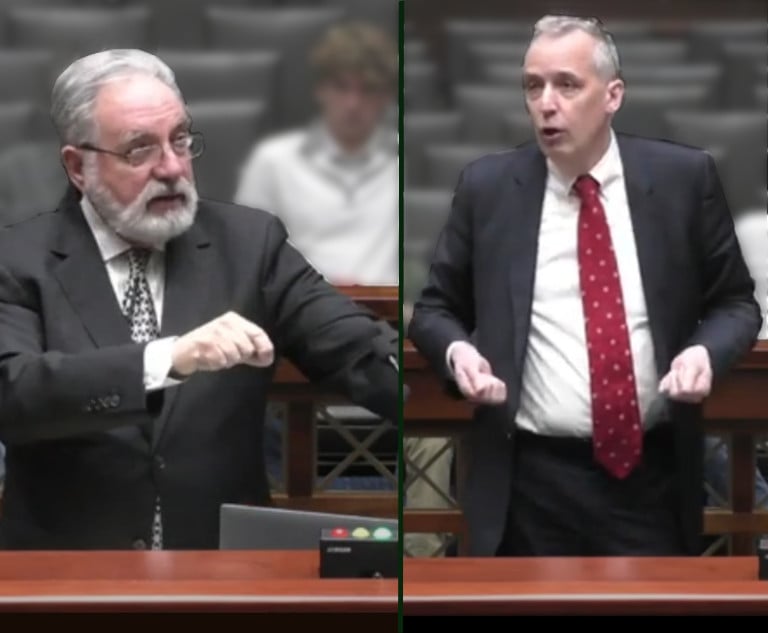Supreme Court to Ponder Issue of First Impression in Stanford Ponzi Scheme Clawback Action
In litigation connected to the Stanford International Bank, the Texas Supreme Court is considering a question of first impression to determine if Stanford's receiver can claw back $79 million from the largest investor of the collapsed Ponzi scheme.
June 03, 2019 at 02:59 PM
4 minute read
 Photo: Elnur/Shutterstock.com
Photo: Elnur/Shutterstock.com
In litigation connected to the Stanford International Bank, the Texas Supreme Court is considering a question of first impression that could determine if Stanford Bank's receiver can claw back $79 million from the largest investor of the collapsed Ponzi scheme.
The U.S. Court of Appeals for the Fifth Circuit vacated its January ruling in the case, Janvey v. GMAG, which found that receiver Ralph Janvey could claw back the money from investor Gary Magness. It found Magness couldn't claim a good-faith defense under the Texas Uniform Fraudulent Transfer Act since he was on notice of the fraudulent nature of funds that Stanford Bank transferred to him in 2008.
The state's high court on May 31 accepted the certified question, which the Fifth Circuit called “a significant issue of first impression” to interpret the uniform fraudulent transfer act's good faith defense. The Fifth Circuit will rehear the appeal after receiving the Texas Supreme Court's answer.
The Fifth Circuit's May 24 certified question provides the background of the case. The U.S. Securities and Exchange Commission in 2009 discovered the Stanford Bank Ponzi scheme in which Stanford Bank issued fraudulent certificates of deposit that promised high returns compared to other banks, but in fact, paid its investors' interest with new investors' funds. Over 18,000 investors lost $7 billion in the Ponzi scheme and the district court appointed Janvey as the receiver to recover and distribute Stanford Bank's assets to its victims.
Magness and entities where he keeps his wealth were among Stanford Bank's largest investors, with $79 million in certificates of deposit. Shortly after news broke in 2008 that the SEC was investigating Stanford Bank, Magness's financial adviser approached Stanford for a redemption. Stanford Bank suggested that Magness take loans on his accumulated interest instead, and Magness received multiple transfers totaling $88.2 million.
Janvey sued Magness to recover the funds, alleging they were fraudulent transfers and amounted to unjust enrichment. He won partial summary judgment to recover $8.5 million that exceeded Magness' initial investment.
The receiver sought a ruling that the remaining $79 million was fraudulent transfers, but Magness countered that he was entitled to the Texas Uniform Fraudulent Transfer Act's good-faith defense.
A jury found that Magness had inquiry notice of the fraudulent nature of the transfers. The district court found Magness should have conducted a diligent investigation, but did not. Even if he had investigated, it would have been futile because he couldn't have learned of the Ponzi scheme, the court ruled, finding he was entitled to the good-faith defense.
Janvey appealed to the Fifth Circuit, which disagreed with the lower court. It ruled for Janvey in January that the jury's finding that Magness had inquiry notice of the fraudulent nature of the transfers did defeat his good-faith defense. Next, Magness asked the panel to rehear the case, arguing that the Fifth Circuit should certify a question about the good-faith defense to the Texas Supreme Court.
The Fifth Circuit explained, “This brings us to the crux of this case: does TUFTA good faith require a transferee on inquiry notice to conduct an investigation, and if so, can that transferee retain the good-faith defense if he does not conduct an investigation but later convinces the factfinder that such an investigation would not have turned up the fraudulent purpose?”
Ballard Spahr partner Drew Petrie of Denver, who represents Magness, said it's an important and open question in Texas Law that the state's high court should decide.
“Our position is the law of inquiry notice or constructive notice is the objective standard that always requires a determination of whether it was knowable that there was something wrong,” he said. “In my perfect world, that's what would come back.”
But Baker Botts partner Kevin Sadler of Palo Alto, California, who represents Janvey, wrote in an email that Janvey is confident the Fifth Circuit decided the case correctly.
Sadler wrote, “The receiver looks forward to a decision from the Texas Supreme Court that will finally put to an end Magness' efforts to retain tens of millions of dollars in funds which rightfully belong to the victims of Stanford's fraud.”
Read the certified question.
This content has been archived. It is available through our partners, LexisNexis® and Bloomberg Law.
To view this content, please continue to their sites.
Not a Lexis Subscriber?
Subscribe Now
Not a Bloomberg Law Subscriber?
Subscribe Now
NOT FOR REPRINT
© 2025 ALM Global, LLC, All Rights Reserved. Request academic re-use from www.copyright.com. All other uses, submit a request to [email protected]. For more information visit Asset & Logo Licensing.
You Might Like
View All
Haynes and Boone Expands in New York With 7-Lawyer Seward & Kissel Fund Finance, Securitization Team
3 minute read
Texas Supreme Court Grapples Over Fifth Circuit Question on State Usury Law
5 minute read
Ex-Six Flags CLO Lands New C-Suite Post—This Time as HR Chief

Paxton's 2024 Agenda: Immigration, Climate, Transgender Issues, Social Media, Abortion, Elections
9 minute readTrending Stories
- 1Thursday Newspaper
- 2Public Notices/Calendars
- 3Judicial Ethics Opinion 24-117
- 4Rejuvenation of a Sharp Employer Non-Compete Tool: Delaware Supreme Court Reinvigorates the Employee Choice Doctrine
- 5Mastering Litigation in New York’s Commercial Division Part V, Leave It to the Experts: Expert Discovery in the New York Commercial Division
Who Got The Work
J. Brugh Lower of Gibbons has entered an appearance for industrial equipment supplier Devco Corporation in a pending trademark infringement lawsuit. The suit, accusing the defendant of selling knock-off Graco products, was filed Dec. 18 in New Jersey District Court by Rivkin Radler on behalf of Graco Inc. and Graco Minnesota. The case, assigned to U.S. District Judge Zahid N. Quraishi, is 3:24-cv-11294, Graco Inc. et al v. Devco Corporation.
Who Got The Work
Rebecca Maller-Stein and Kent A. Yalowitz of Arnold & Porter Kaye Scholer have entered their appearances for Hanaco Venture Capital and its executives, Lior Prosor and David Frankel, in a pending securities lawsuit. The action, filed on Dec. 24 in New York Southern District Court by Zell, Aron & Co. on behalf of Goldeneye Advisors, accuses the defendants of negligently and fraudulently managing the plaintiff's $1 million investment. The case, assigned to U.S. District Judge Vernon S. Broderick, is 1:24-cv-09918, Goldeneye Advisors, LLC v. Hanaco Venture Capital, Ltd. et al.
Who Got The Work
Attorneys from A&O Shearman has stepped in as defense counsel for Toronto-Dominion Bank and other defendants in a pending securities class action. The suit, filed Dec. 11 in New York Southern District Court by Bleichmar Fonti & Auld, accuses the defendants of concealing the bank's 'pervasive' deficiencies in regards to its compliance with the Bank Secrecy Act and the quality of its anti-money laundering controls. The case, assigned to U.S. District Judge Arun Subramanian, is 1:24-cv-09445, Gonzalez v. The Toronto-Dominion Bank et al.
Who Got The Work
Crown Castle International, a Pennsylvania company providing shared communications infrastructure, has turned to Luke D. Wolf of Gordon Rees Scully Mansukhani to fend off a pending breach-of-contract lawsuit. The court action, filed Nov. 25 in Michigan Eastern District Court by Hooper Hathaway PC on behalf of The Town Residences LLC, accuses Crown Castle of failing to transfer approximately $30,000 in utility payments from T-Mobile in breach of a roof-top lease and assignment agreement. The case, assigned to U.S. District Judge Susan K. Declercq, is 2:24-cv-13131, The Town Residences LLC v. T-Mobile US, Inc. et al.
Who Got The Work
Wilfred P. Coronato and Daniel M. Schwartz of McCarter & English have stepped in as defense counsel to Electrolux Home Products Inc. in a pending product liability lawsuit. The court action, filed Nov. 26 in New York Eastern District Court by Poulos Lopiccolo PC and Nagel Rice LLP on behalf of David Stern, alleges that the defendant's refrigerators’ drawers and shelving repeatedly break and fall apart within months after purchase. The case, assigned to U.S. District Judge Joan M. Azrack, is 2:24-cv-08204, Stern v. Electrolux Home Products, Inc.
Featured Firms
Law Offices of Gary Martin Hays & Associates, P.C.
(470) 294-1674
Law Offices of Mark E. Salomone
(857) 444-6468
Smith & Hassler
(713) 739-1250






